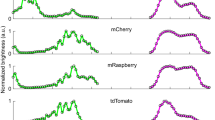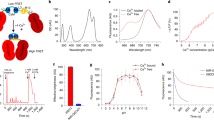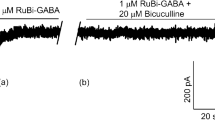Abstract
We have synthesized a photosensitive (or caged) 4-carboxymethoxy-5,7-dinitroindolinyl (CDNI) derivative of γ-aminobutyric acid (GABA). Two-photon excitation of CDNI-GABA produced rapid activation of GABAergic currents in neurons in brain slices with an axial resolution of approximately 2 μm and enabled high-resolution functional mapping of GABA-A receptors. Two-photon uncaging of GABA, the main inhibitory neurotransmitter, should allow detailed studies of receptor function and synaptic integration with subcellular precision.
This is a preview of subscription content, access via your institution
Access options
Subscribe to this journal
Receive 12 print issues and online access
$259.00 per year
only $21.58 per issue
Buy this article
- Purchase on Springer Link
- Instant access to full article PDF
Prices may be subject to local taxes which are calculated during checkout


Similar content being viewed by others
References
Denk, W. & Svoboda, K. Neuron 18, 351–357 (1997).
Svoboda, K. & Yasuda, R. Neuron 50, 823–839 (2006).
Matsuzaki, M. et al. Nat. Neurosci. 4, 1086–1092 (2001).
Ellis-Davies, G.C.R., Matsuzaki, M., Paukert, M., Kasai, H. & Bergles, D.E. J. Neurosci. 27, 6601–6604 (2007).
Matsuzaki, M., Ellis-Davies, G.C.R. & Kasai, H. J. Neurophysiol. 99, 1535–1544 (2008).
Ellis-Davies, G.C.R. New Encyclopedia of Neuroscience, e876 (Academic Press, 2008).
Beique, J.C. et al. Proc. Natl. Acad. Sci. USA 103, 19535–19540 (2006).
Shankar, G.M. et al. J. Neurosci. 27, 2866–2875 (2007).
Asrican, B., Lisman, J. & Otmakhov, N. J. Neurosci. 27, 14007–14011 (2007).
Smith, M.A., Ellis-Davies, G.C.R. & Magee, J.C. J. Physiol. (Lond.) 548, 245–258 (2003).
Megias, M., Emri, Z., Freund, T.F. & Gulyas, A.I. Neuroscience 102, 527–540 (2001).
Kawaguchi, Y. & Kubota, Y. Cereb. Cortex 7, 476–486 (1997).
Nusser, Z., Sieghart, W., Benke, D., Fritschy, J.M. & Somogyi, P. Proc. Natl. Acad. Sci. USA 93, 11939–11944 (1996).
Nyiri, G., Freund, T.F. & Somogyi, P. Eur. J. Neurosci. 13, 428–442 (2001).
Eder, M., Zieglgansberger, W. & Dodt, H.U. Rev. Neurosci. 15, 167–183 (2004).
Gee, K.R., Wieboldt, R. & Hess, G.P. J. Am. Chem. Soc. 116, 8366–8367 (1994).
Molnar, P. & Nadler, J.V. Eur. J. Pharmacol. 391, 255–262 (2000).
Alvina, K., Walter, J.T., Kohn, A., Ellis-Davies, G. & Khodakhah, K. Nat. Neurosci. 11, 1256–1258 (2008).
Curten, B., Kullmann, P.H.M., Bier, M.E., Kandler, K. & Schmidt, B.F. Photochem. Photobiol. 81, 641–648 (2005).
Zayat, L. et al. ChemBioChem 8, 2035–2038 (2007).
Papageorgiou, G. & Corrie, J.E.T. Tetrahedron 63, 9668–9676 (2007).
Carter, A.G. & Sabatini, B.L. Neuron 44, 483–493 (2004).
Araya, R., Eisenthal, K.B. & Yuste, R. Proc. Natl. Acad. Sci. USA 103, 18799–18804 (2006).
Sobczyk, A., Scheuss, V. & Svoboda, K. J. Neurosci. 25, 6037–6046 (2005).
Remy, S., Csicsvari, J. & Beck, H. Neuron 61, 906–916 (2009).
Acknowledgements
This work was supported by US National Institutes of Health grant GM53395 (to G.C.R.E.-D.), a Grant-in-Aid for Scientific Research on Priority Areas (Elucidation of neural network function in the brain, number 20021008, to M.M.), a Grant-in-Aid for Young Scientists (A) (number 19680020, to M.M.) from the Ministry of Education, Culture, Sports, Science, and Technology (MEXT) of Japan, and funding from Precursory Research for Embryonic Science and Technology (PRESTO), Japan Science and Technology Agency (to M.M.).
Author information
Authors and Affiliations
Contributions
G.C.R.E.-D. made and characterized the caged compounds. M.M. and T.H. performed biological experiments and analyzed the data. H.K. provided resources and support for the biological experiments. G.C.R.E.-D. and M.M. wrote the manuscript.
Corresponding authors
Ethics declarations
Competing interests
G.C.R.E.-D. has filed a patent on dinitroindolinyl caged compounds.
Supplementary information
Supplementary Text and Figures
Supplementary Methods, Supplementary Figures 1–3 and Supplementary Table 1 (PDF 798 kb)
Rights and permissions
About this article
Cite this article
Matsuzaki, M., Hayama, T., Kasai, H. et al. Two-photon uncaging of γ-aminobutyric acid in intact brain tissue. Nat Chem Biol 6, 255–257 (2010). https://doi.org/10.1038/nchembio.321
Received:
Accepted:
Published:
Issue Date:
DOI: https://doi.org/10.1038/nchembio.321
This article is cited by
-
In vivo spatiotemporal control of voltage-gated ion channels by using photoactivatable peptidic toxins
Nature Communications (2022)
-
Light-triggered elimination of CO2 and absorption of O2 (artificial breathing reaction) in photolysis of 2-(4-nitrophenyl)-1H-indole derivatives
Photochemical & Photobiological Sciences (2021)
-
Optical control of neuronal ion channels and receptors
Nature Reviews Neuroscience (2019)
-
Photoactivatable drugs for nicotinic optopharmacology
Nature Methods (2018)
-
GABA promotes the competitive selection of dendritic spines by controlling local Ca2+ signaling
Nature Neuroscience (2013)



